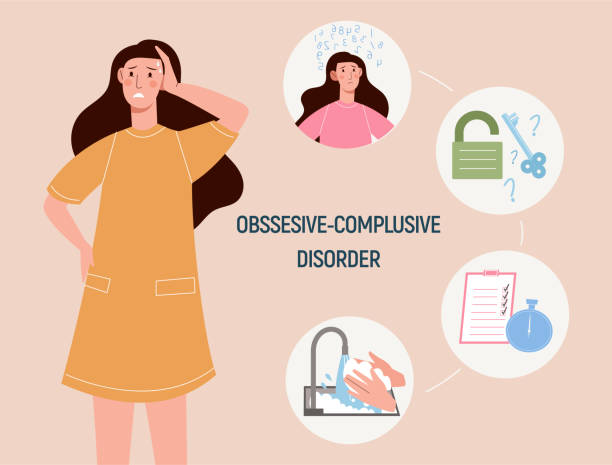Obsessive-Compulsive Disorder (OCD): An In-Depth Analysis
Obsessive-Compulsive Disorder (OCD): An In-Depth Analysis

Obsessive-Compulsive Disorder (OCD) is a prevalent mental health condition with a global impact, affecting millions of individuals. It’s characterized by persistent, unwanted thoughts (obsessions) and repetitive behaviors (compulsions) that individuals feel compelled to perform. These obsessions and compulsions can significantly interfere with a person’s daily life and well-being. This article aims to provide a comprehensive understanding of OCD symptoms, causes, and treatment options. And the impact it has on individuals and their loved ones.
what is OCD?
Obsessive-Compulsive Disorder (OCD) is a mental health condition characterized by intrusive, persistent thoughts (obsessions) and repetitive behaviors (compulsions) that an individual feels compelled to perform. These obsessions can trigger significant anxiety, leading to compulsions aimed at alleviating the distress, though the rituals often provide only temporary relief. The exact cause of OCD is unknown, but it is thought to involve a combination of genetic, neurological, and environmental factors. The condition can significantly impact daily functioning and quality of life, but with appropriate treatment strategies, such as medication and cognitive-behavioral therapy, individuals can manage the symptoms and lead productive lives.

Symptoms of OCD
Obsessive-Compulsive Disorder (OCD) manifests through a range of symptoms categorized into two main types: obsessions and compulsions. Understanding these symptoms in detail can provide deeper insights into the complexities of the disorder:
Obsessions
Intrusive thoughts, images, or urges that cause distress or anxiety characterize intrusive sessions. These thoughts are not simply excessive worries about real-life problems but are often irrational or exaggerated. Common obsessions include:
- Contamination fears: Fear of germs, dirt, or becoming ill; excessive concern about cleanliness.
- Fears of harm: Fear of causing harm to oneself or others, often accompanied by mental images of violent or aggressive actions.
- Need for symmetry or exactness: An overwhelming desire for objects to be placed in a particular order or position, or for actions to be done symmetrically or perfectly.
- Forbidden thoughts: Intrusive and unwanted thoughts involving aggression, sexual content, or blasphemous themes, which are often contrary to the individual’s values or beliefs.
- Hoarding fears: Persistent worry about discarding items, often leading to the accumulation of unnecessary or valueless things.
Compulsions
- Cleaning and washing: Excessive handwashing, showering, or cleaning of objects and environments to reduce fears of contamination.
- Checking: Repeatedly verifying that a door is locked, appliances are off, or repeatedly checking for mistakes.
- Counting, tapping, touching, or repeating: Performing actions a certain number of times or in a specific manner to reduce anxiety or prevent a feared outcome.
- Ordering and arranging: Placing items in a particular way or order, and experiencing distress when items are disordered or asymmetric.
- Mental compulsions: Silently repeating words, praying, or performing rituals in one’s mind to counteract anxiety or fend off feared events.
Individuals with OCD often recognize that their obsessions and compulsions are irrational, yet they feel unable to control them. The severity of symptoms can vary, with stress often worsening the intensity of the obsessions and compulsions. Despite the challenges posed by these symptoms, effective treatments like cognitive-behavioral therapy and medication can significantly improve the quality of life for those affected by OCD.

Causes of OCD
The exact causes of Obsessive-Compulsive Disorder (OCD) are not fully understood, but research indicates that a combination of genetic, neurological, behavioral, cognitive, and environmental factors contribute to its development. Here’s a detailed look at each of these contributing factors:
Genetic Factors
- Family History: There’s a higher risk of developing OCD if a first-degree relative (such as a parent, sibling, or child) has the disorder. Studies suggest a significant genetic component, although the specific genes involved are not yet fully identified.
- Twin Studies: Research on twins has shown that identical twins are more likely to both have OCD than fraternal twins, indicating a genetic influence.
Neurological Factors
- Brain Structure and Function: Imaging studies have shown differences in the frontal cortex and subcortical structures of the brain in individuals with OCD. These areas are involved in executive function, decision making, and response to fear and anxiety.
- Neurotransmitter Imbalance: Serotonin, a neurotransmitter, is believed to play a crucial role in OCD. Imbalances in serotonin levels, and possibly other neurotransmitters like dopamine and glutamate, are linked to the pathophysiology of OCD.

Behavioral Factors
- Learning Theories: Behavioral theories suggest that compulsions are learned responses that help reduce the anxiety associated with obsessions. Over time, these behaviors are reinforced because they provide temporary relief from distress.
Cognitive Factors
- Faulty Beliefs: People with OCD often have dysfunctional beliefs and an exaggerated sense of responsibility, leading to the misinterpretation of thoughts as more significant or dangerous than they are. This can increase anxiety and the need to perform compulsive behaviors.
- Cognitive Distortions: Individuals with OCD may exhibit cognitive distortions, such as overestimating threats, perfectionism, and an excessive need for control, which can fuel obsessive-compulsive symptoms.
Environmental Factors
- Stressful Life Events: Significant life stressors or changes, such as the loss of a loved one, may trigger the onset of OCD or exacerbate existing symptoms.
- Behavioral Conditioning: Some theories suggest that OCD symptoms may develop in response to environmental factors through a process called conditioning. For example, if a person associates a particular object or situation with fear, they might begin to avoid that trigger, which can evolve into a compulsion.
Epigenetics
- Gene-Environment Interaction: Epigenetic factors, which influence how genes are expressed without altering the DNA sequence, may also play a role in OCD. Environmental factors can affect gene expression and contribute to the development of the disorder.
While the understanding of OCD’s causes is evolving, it’s clear that the disorder results from a complex interplay of various factors. This multifaceted perspective helps inform more effective, personalized treatment approaches for individuals affected by OCD.

Treatment Options
Treatment for Obsessive-Compulsive Disorder (OCD) typically involves a combination of psychotherapy and OCD symptoms, to control symptoms to a level where they do not significantly interfere with daily functioning. Here’s an overview of the primary treatment options for OCD:
1. Psychotherapy
- Cognitive-Behavioral Therapy (CBT): CBT is one of the most effective forms of psychotherapy for OCD. It involves identifying and challenging the distorted cognitions and beliefs that fuel obsessive thoughts and compulsive behaviors.
- Exposure and Response Prevention (ERP): ERP, a specific type of CBT, is considered the gold standard for OCD treatment. It involves exposing the person to the source of their anxiety or obsession (exposure) and then helping them learn not to perform their usual compulsion (response prevention). Over time, ERP can reduce the intensity of the obsession and the urge to perform compulsions.
- Acceptance and Commitment Therapy (ACT): ACT helps individuals accept their thoughts without trying to alter or eliminate them, focusing on behaving in ways consistent with personal values rather than being driven by obsessive thoughts.
2. Medication
- Selective Serotonin Reuptake Inhibitors (SSRIs): These are the primary type of medication prescribed for OCD, helping to increase levels of serotonin in the brain. Examples include fluoxetine, sertraline, and fluvoxamine.
- Tricyclic Antidepressants (TCAs): In cases where SSRIs are not effective, TCAs like clomipramine may be prescribed. However, TCAs often have more side effects compared to SSRIs.
- Other Medications: In some cases, other psychiatric medications, such as antipsychotics or mood stabilizers. May be added to enhance the treatment, particularly if there are co-occurring disorders.
3. Neuromodulation Therapies
For individuals who do not respond adequately to medication and psychotherapy, advanced treatment options like neuromodulation may be considered:
- Transcranial Magnetic Stimulation (TMS): A non-invasive procedure that uses magnetic fields to stimulate nerve cells in the brain to improve symptoms of OCD.
- Deep Brain Stimulation (DBS): A surgical treatment option for severe, treatment-resistant OCD, involving the implantation of electrodes in specific areas of the brain.

4. Lifestyle and Self-Care
- Stress Management: Techniques like meditation, yoga, and regular exercise can help manage stress and potentially reduce OCD symptoms.
- Support Groups: Joining OCD support groups can provide emotional support, education, and coping strategies for others experiencing similar challenges.
- Healthy Habits: Maintaining a routine, getting adequate sleep, and eating a balanced diet can also support overall mental health.
5. Treatment Integration
- Comprehensive Approach: Often, a combination of therapies is most effective. A personalized treatment plan often integrates medication and psychotherapy. Tailored to the individual’s specific symptoms and needs, yields the best outcomes.
Living with OCD
Living with OCD can be challenging, not just for the individual but also for their family and friends. Those affected by OCD must seek support. Whether through professional help, support groups, or education about the disorder. Understanding and compassion from loved ones can make a significant difference in the life of someone struggling with OCD.

Conclusion
OCD is a complex disorder that can significantly impact the quality of life of those affected. If you or someone you know is struggling with OCD. It’s important to seek professional help to navigate the challenges of this condition and work towards recovery.





